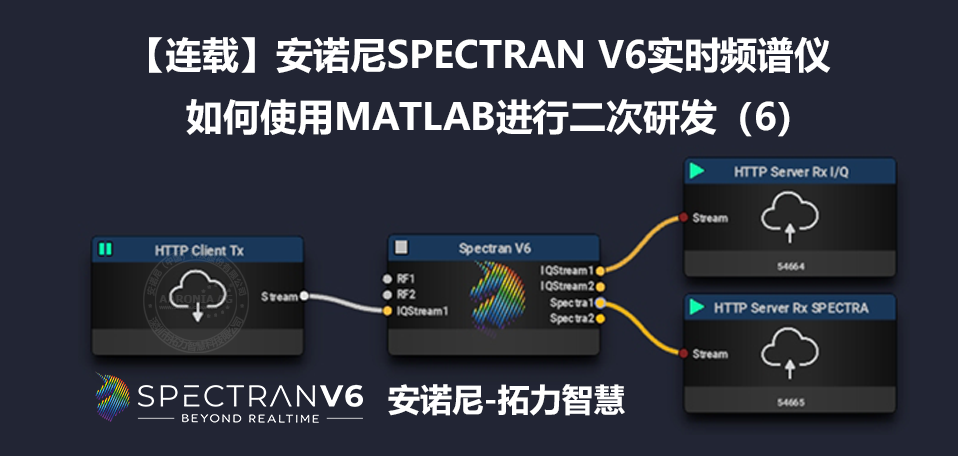安诺尼AARONIA SPECTRAN V6实时频谱仪是AARONIA AG最新研发生产的新一代高性能实时频谱分析仪。
SPECTRAN V6的最大实时带宽高达245MHz,扫描速度超过1THz / s,POI更是低至10ns,SPECTRAN V6出色的技术参数是用户的理想选择。
SPECTRAN V6实时频谱仪随货提供RTSA-Suite PRO实时频谱分析软件(基础功能免费),内置100+任务脚本,用户可以根据需求快速调用,提升测量效率。
拓力智慧为了适应国内用户使用和二次开发的需求,配备了专业的支持团队,能为用户提供深度的二次开发支持,以下是安诺尼AARONIA实时频谱仪关于MATLAB研发应用说明
-----------------------------------------------------------------------------------------------------------------------------
8、安诺尼实时频谱分析仪二次研发的控制端点(Control Endpoint )说明
Depending on its functionality each configuration block of the Aaronia-RTSA-Suite accepts control
commands for example the start/stop command. These commands are not addressed to a specific RTSA
block and will be processed from all RTSA blocks in the block graph configuration.
Following control HTTP PUT request(http://localhost:54664/control) will start all streaming related
blocks at the remote configuration site. To stop the streaming the value of start needs to be set to false:
{
"start" : true, "type" : "streaming"
}\n'
Sending a put request is problematic using a web browser, but can be done using e.g. “curl” as a
command line tool.
curl -X PUT -d "{\"start\":false, \"type\":\"streaming\"}"
http://localhost:54664/control
To set the frequency range of the measurement devices, following fields are used:
{
"frequencyCenter" : 1200000000,
"frequencySpan" : 44000000,
"frequencyBins" : 448,
"referenceLevel" : -20,
"type" : "capture"
}\n'
Using curl:
curl -X PUT -d "{\"frequencyCenter\":1920.0e6, \"frequencySpan\":200.0e6,
\"type\":\"capture\"}" http://localhost:54664/control
An alternative way would be to specify the start and end frequency.
{
"frequencyStart" : 75.0e6,
"frequencyEnd" : 6000.0e6,
"type" : "capture"
}\n'
To start or stop the autorotation of all antennas in the remote block graph configuration, following fields
are used:
{
"rotate" : true,
"type" : "antenna"
}\n'
To start a record, following fields are used:
{
"start" : true,
"filename" : “xy”
"type" : "recording"
}\n'
To save or reload the running mission, following fields are used:
{
"save" : true, "type" : "mission"
}\n'
{
"reload" : true,
"type" : "mission"
}\n'
Configuration Data
Server Info
The “/info” endpoint provides information of the http server block, such as name, title, port, features
and the name and path of the mission http://localhost:54664/info.
{
"name" : "Block_HTTPServer_0",
"title" : "HTTP Server",
"uuid" : "aaf2a8f7-11fa-45a3-bcfc-26aaf5957629",
"port" : 54664,
"mission" : ""
}
General
All configuration items visible in the configuration blocks of the Aaronia-RTSA-Suite have a
representation as JSON. The list of available configuration items can be queried with the
“/remoteconfig” endpoint http://localhost:54664/remoteconfig.
The resulting JSON looks like this.
{
"request": 0,
"config": {
"type" : "group",
"name" : "remoteconfig",
"label": "RemoteConfig",
"items": [{
"type" : "group",
"name" : "Block_FileReader_0",
"label": "File Reader",
…
The configuration data forms a tree with the root being placed into the config member of the top-level
object. The second tree level is populated with the blocks of the graph, all further levels by configuration
elements of these blocks.
All config items share the following fields:

Leaf nodes carry configuration data, internal nodes have the type “group” and contain their child nodes
in a member named “items”. Leaf nodes provide their current value in the member “value” and the
default value in the member “default”.
Leaf Node Metadata
The following members can be found in leaf nodes and provide meta data.

All configuration items visible and editable in a configuration block of the Aaronia-RTSA-Suite can be
changed via the “/remoteconfig” endpoint and a HTTP PUT request. Each configuration block has a
unique name in a Aaronia-RTSA-Suite mission. This name is used to address a specific RTSA block. The
unique name for each RTSA block is provided in the response of the “/remoteconfig” HTTP GET request
and is static in an unchanged mission. Each “/remoteconfig” HTTP PUT request will be answered with the
same response a HTTP GET request will initiate.
A JSON “/remoteconfig” HTTP PUT request starts with the following fields:
{
"request" : 0,
"config" : {
"type" : "group",
"name" : "Block_Spectran_0",
"items" : [ {
…

A HTTP PUT request to enable the amplifier of a Spectran V5 RTSA block for example, looks like the
following:
{
"request" : 1, "config" : {
"type" : "group",
"name" : "Block_Spectran_0",
"items" : [{
"type" : "group",
"name" : "main",
"label" : "Main",
"items" : [{
"type" : "bool",
"name" : "amplifier",
"value" : true
}]
}]
}
}

《安诺尼实时频谱分析仪如何使用MATLAB进行二次研发》的相关内容将以连载的方式进行更新,这是连载的第6期,感谢您的阅读。


